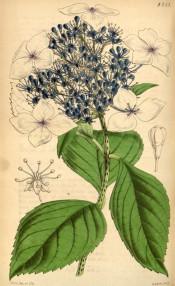Hydrangea macrophylla (Thunb.) Ser. subsp. serrata (Thunb.) Makino
Fully hardy, compact, erect, deciduous shrub with narrow, ovate, pointed leaves, to 15cm long, and flattened corymbs, to 10cm across, composed of numerous white, sterile flowers around the outside, with small pink or blue, fertile flowers in the centre, from summer to autumn. To 1.2m or more under suitable conditions. [RHSE, Hilliers’, Hortus].
Horticultural & Botanical History
‘Japan seems to abound with Hydrangeas, Siebold having described as many as fourteen from that country. In this respect, as in many others, we have the indication of a near relation between the flowers of Japan and North America. It does not, however, appear that they are very handsome, and in this respect too they agree with the American species.’ [BR f.61/1844 as Hydrangea japonica].
‘We have been so long accustomed to see the old Hydrangea hortensis produce its immense flower-heads of a bluish, or a rosy hue, either upon the same or separate specimens, that we almost cease to regard the matter as anything singular or wonderful. Of late years another species has been introduced, which also displays both colours, but whether they are produced by different varieties, or by the same plant under different circumstances, seems to be yet a matter of dispute. […] According to Siebold, who discovered the plant and transmitted specimens to Europe, its vernacular title is Kakoosa; and there are two varieties of it, which the natives distinguish as Benkaku and Konkaku, the first with red and the second with greyish-blue flowers. […] The plant has an excellent free habit, emitting branches from every part, and seldom exceeding eighteen inches or two feet in height. The foliage is large and bold, but not so closely arranged as in the old kind. The flower heads, though possessing considerable beauty, are flat, and by no means so magnificent as the enormous clusters of its congener: the blue-coloured ones are decidedly the prettiest.’ [MB p.199/1845].
Hydrangea japonica fol. albo-variegatis is figured in Flore des Serres, FS f.696/1851-52. This is identical to the plants figured in the Botanical Register and Paxton’s Magazine of Botany except that its leaves are variegated with white.
Hydrangea japonica was introduced to Britain in 1843 by Dr. Siebold, who found it growing wild on Nipon Island, and cultivated widely. [JD, BM t.4253/1846]. OFG f.102/1854.
History at Camden Park
Listed in the 1845, 1850 and 1857 catalogues [T.566/1845]. ‘Hydrangea japonica has flowered. The plant does not do well at Camden (Hydrangeas never would prove well here). The corymb or [undeciphered] consists of a few barren anthered florets with petals like the common Hydrangea round the outside with numerous other florets within, having their anthers perfect but no petals!’ Macarthur to Bidwill, 25th November, 1845. [MP A2933-2, p.98]. On the 17th July 1846 he wrote to James Graham of Melbourne that ‘the Hydrangea Japonica is also the only plant in the colony’ and he did not have it for sale [MP A2933-2, p.178].
Notes
Published Feb 14, 2010 - 12:02 PM | Last updated Feb 14, 2010 - 12:10 PM
| Family | Hydrangeaceae |
|---|---|
| Category | |
| Region of origin | Korea, Japan |
| Synonyms |
|
| Common Name | Lace cap hydrangea |
| Name in the Camden Park Record |
Hydrangea Japonica |
| Confidence level | high |


